While expanding their business and product range, businesses harm the environment unwillingly by increasing their carbon footprint. Customers are aware of this and support clothing companies that care for their surroundings.
So, clothing companies are striving to adopt sustainable practices.
Utilising a circular model for making the business sustainable has become a popular strategy. The strategy aims to reduce pollution, reuse available resources and recycle materials. However, adopting such a policy isn’t straightforward.
The article talks about how clothing companies can alter their business practices to include circularity and protect their surroundings.
Reduce Waste Production by Analysing Materials
Clothing companies and industries are notorious for polluting the environment through waste production. They might dump harmful chemicals into nearby water bodies or contaminate the soil. This has to stop if a company wishes to adopt a circular model.
- If you are a company owner, you can hire environmental scientists and engineers to look into the matter.
- Determine the products and manufacturing practices that produce the most amount of waste.
- Take the necessary steps to modify and control these practices.
- You can reduce the raw materials usually needed for manufacturing goods.
Moreover, analyse the materials and their environmental impact before selecting them. For instance, wool is a rapidly renewable, biodegradable, recyclable, and organically produced material. You can protect the surroundings by switching to wool and similar fabrics.
Rethink Collaborations with Other Firms
When collaborating with other companies for production, check their sustainability practices. Focus on the type of raw materials they use and their recycling strategies. Also, check whether they adopt sustainability for their business operations.
In addition, you can also choose to work with local suppliers, companies, and distributors. It will allow you to maintain eco-friendly and short transport routes. Plus, it will reduce pollution.
That’s why conducting a detailed environmental analysis of the product manufacturing practices of another firm is crucial.
Promote Circularity and Sustainability
To embrace the circular and sustainable business model, everyone needs to know about the concepts. You can leverage technology like ERP software, messaging platforms, and even IoT to spread information.
Ensure that everyone has access to updated information on sustainable usage of raw materials and better manufacturing practices. You can highlight these concepts during meetings and corporate events.
Moreover, organise seminars and conferences to discuss sustainability in-depth. Make sure that the sustainability principles are easily understandable for all. You can send virtual resources like e-books, case studies, videos, and pdfs to exchange more information.
Developing a culture of sustainability will help you adopt it more effectively.
Start Small Instead Of Taking Elaborate Steps
You don’t need to transform all your manufacturing practices overnight to become sustainable. Such a step can disrupt your organisational operations and supply chain processes. So, start something small but significant.
For example, you can replace your packaging material with biodegradable plastic. Use the material to pack a small amount of cargo or products. Then, measure the results to see the changes in environmental impact.
If you notice differences in the carbon footprint or pollution rate, you can move ahead with the initiative. Otherwise, gather your environmental science team and develop new ideas.
The Bottom Line
There might be more plastic in the oceans than sea by 2050!
So, the best way to implement a circular and sustainable business model is to take eco-friendly initiatives. Besides modifying your business practices, conduct reforestation drives, restore polluted areas, and keep analysing the impacts.
These steps will encourage employees and stakeholders to be aware of the need for sustainability.

